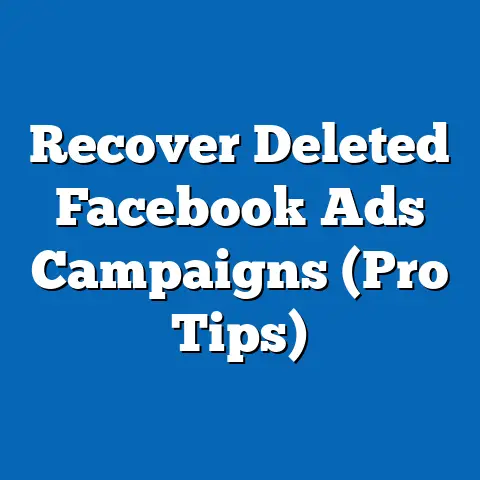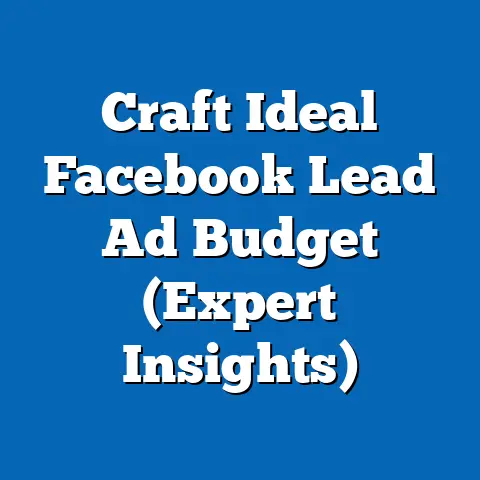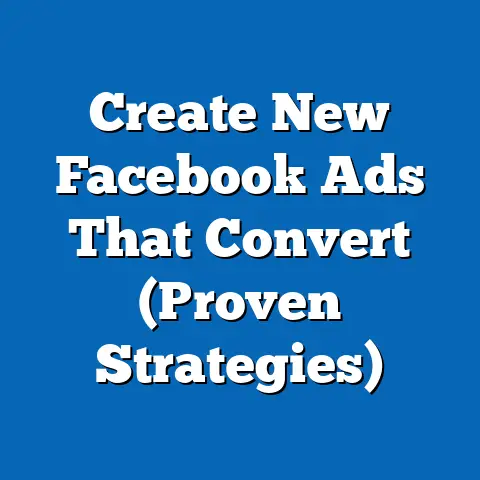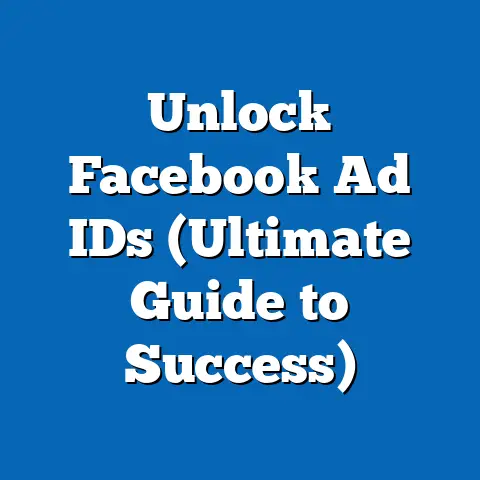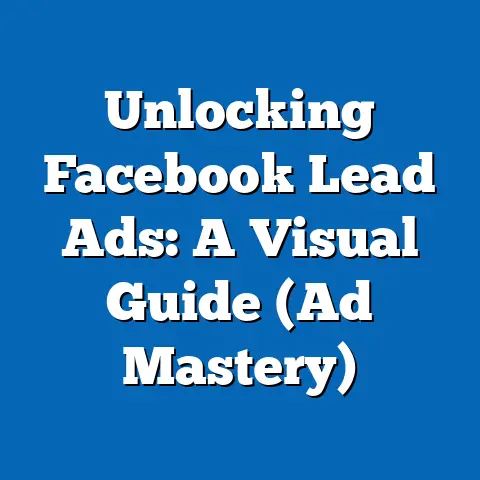Overcoming Facebook Ads Challenges (Proven Strategies Revealed)
Have you ever dreamed of a life where your business runs smoothly, generating consistent income, leaving you with the freedom to pursue your passions, spend quality time with loved ones, or even travel the world? I know I have! For many entrepreneurs and marketers, that dream feels tantalizingly close, yet often remains just out of reach. The culprit? Often, it’s the frustrating maze of online advertising, particularly the ever-evolving world of Facebook Ads.
I’ve spent years navigating the complexities of Facebook Ads, and I’ve seen firsthand how challenging it can be. But I’ve also witnessed the incredible power it holds. I remember working with a local bakery owner who was struggling to stay afloat. After implementing a targeted Facebook ad campaign focusing on local customers and highlighting their unique pastries, their sales skyrocketed. Within months, they were not only profitable but also planning an expansion!
The truth is, Facebook Ads can be a game-changer, but only if you can overcome the hurdles that stand in your way. That’s why I’ve created this guide – to share proven strategies that will help you navigate the common challenges of Facebook advertising and unlock its potential to transform your business and, ultimately, your lifestyle.
Understanding the Common Challenges of Facebook Ads
Before diving into the solutions, it’s crucial to understand the specific challenges that plague many Facebook advertisers. Ignoring these obstacles is like trying to build a house on a shaky foundation – eventually, it will crumble. Let’s explore some of the most prevalent issues:
- Ad Fatigue: This is the bane of every marketer’s existence. Your target audience gets tired of seeing the same ad repeatedly, leading to decreased engagement and a drop in performance. Think about it – how many times have you scrolled past the same ad without even registering it?
- Targeting the Right Audience: Reaching the wrong people is like shouting into a void. If your ads aren’t seen by potential customers, you’re wasting your budget and getting nowhere. I’ve seen campaigns targeting broad demographics with generic messaging, resulting in abysmal click-through rates and zero conversions.
- Fluctuating Costs: The cost of Facebook Ads can be unpredictable, influenced by factors like competition, seasonality, and ad quality. This makes it difficult to budget effectively and maintain a consistent return on investment (ROI).
- Ad Approval Processes: Facebook’s ad policies are complex and constantly evolving. Getting your ads rejected can be frustrating and time-consuming, delaying your campaigns and impacting your results. I once had a client whose entire launch strategy was derailed because their ads were repeatedly disapproved due to a misunderstanding of Facebook’s guidelines on health claims.
- Measuring Return on Investment (ROI): It’s not enough to just run ads; you need to know if they’re actually working. Many marketers struggle to accurately track conversions and attribute sales to their Facebook advertising efforts, making it difficult to justify their ad spend.
These challenges are real, and they can be daunting. In fact, studies show that up to 60% of small businesses find Facebook advertising to be ineffective, primarily due to these issues. But don’t despair! I’m here to tell you that these challenges can be overcome with the right strategies and a bit of persistence.
Takeaway: Understanding the common challenges of Facebook Ads is the first step towards overcoming them. By recognizing these obstacles, you can proactively implement strategies to mitigate their impact and maximize your advertising ROI.
Strategy 1 – Crafting Compelling Ad Copy and Creative
Ad fatigue is a real killer. To overcome this, you need to create ad copy and visuals that are not only engaging but also continuously refreshed and optimized. Here are some strategies I’ve found effective:
- A/B Testing: This is your secret weapon against ad fatigue. Create multiple versions of your ad with different headlines, images, or calls to action. Run them simultaneously and track which ones perform best. I once A/B tested two ads for the same product, one with a humorous headline and one with a straightforward benefit statement. The humorous headline outperformed the other by over 30%!
- Storytelling: People are naturally drawn to stories. Instead of simply listing features, tell a story about how your product or service has helped someone. This creates an emotional connection and makes your ad more memorable. Think about Dove’s “Real Beauty” campaign – it resonated with millions because it told a powerful story about self-acceptance.
- Emotional Triggers: Tap into your audience’s emotions by using words and images that evoke feelings of happiness, excitement, fear, or urgency. For example, if you’re selling security systems, focus on the peace of mind it provides.
- High-Quality Visuals: Invest in professional-quality images and videos. Blurry or poorly designed visuals will turn people off. Consider using user-generated content (UGC), as it often feels more authentic and relatable.
- Regular Refreshments: Don’t let your ads stagnate. Rotate your ad creative regularly, even if your current ads are performing well. This prevents ad fatigue and keeps your audience engaged.
Example: A local coffee shop was struggling to attract new customers. I created a series of ads featuring stunning photos of their latte art and personalized stories about their baristas. One ad featured a barista who had overcome personal challenges to pursue his passion for coffee. This ad not only showcased the coffee shop’s unique offerings but also created a human connection with potential customers.
Takeaway: Compelling ad copy and creative are essential for overcoming ad fatigue and capturing your audience’s attention. By A/B testing, storytelling, using emotional triggers, and regularly refreshing your ad creative, you can keep your ads engaging and drive better results.
Strategy 2 – Mastering Audience Targeting
Targeting the right audience is the key to unlocking the true potential of Facebook Ads. Here’s how to laser-focus your targeting:
- Demographics: Utilize Facebook’s demographic targeting options to reach people based on age, gender, education, location, and other factors. This is a good starting point, but it’s often not enough on its own.
- Interests: Target people based on their interests, hobbies, and passions. This allows you to reach a more specific audience who are likely to be interested in your product or service. I once targeted a campaign for a fitness app to people interested in yoga, running, and healthy eating. The results were significantly better than targeting a broad audience interested in “fitness.”
- Behaviors: Target people based on their online behaviors, such as their purchasing habits, device usage, and travel preferences. This can be a powerful way to reach people who are actively looking for products or services like yours.
- Custom Audiences: Upload your existing customer list (email addresses or phone numbers) to create a custom audience. This allows you to target your most loyal customers or re-engage with people who have interacted with your business in the past.
- Lookalike Audiences: Create a lookalike audience based on your custom audience. Facebook will find people who share similar characteristics and behaviors with your existing customers, expanding your reach to a highly relevant audience.
- Audience Insights: Use Facebook’s Audience Insights tool to analyze your target audience and gain a deeper understanding of their demographics, interests, and behaviors. This information can help you refine your targeting and create more effective ads.
Example: An online clothing store specializing in eco-friendly fashion was struggling to reach their target audience. By using Facebook’s interest targeting options and focusing on people interested in sustainable living, ethical fashion, and environmentalism, they were able to significantly increase their reach and drive more sales.
Takeaway: Precise audience targeting is crucial for maximizing your advertising ROI. By leveraging Facebook’s demographic, interest, behavior, custom, and lookalike audience targeting options, you can reach the right people with the right message and drive better results.
Strategy 3 – Budgeting and Cost Management
Fluctuating costs can be a major headache for Facebook advertisers. Here are some strategies for managing your budget effectively:
- Set a Realistic Budget: Determine how much you’re willing to spend on Facebook Ads and stick to it. Start with a small budget and gradually increase it as you see positive results.
- Understand Bidding Options: Facebook offers various bidding options, including cost per click (CPC), cost per impression (CPM), and cost per conversion (CPA). Choose the bidding option that aligns with your campaign goals. For example, if you’re focused on driving traffic to your website, CPC bidding might be the best option.
- Monitor Ad Performance: Keep a close eye on your ad performance and adjust your budget as needed. If an ad is performing well, consider increasing its budget. If an ad is underperforming, pause it or reduce its budget.
- Optimize Ad Relevance: Facebook rewards ads that are relevant to the target audience with lower costs. Improve your ad relevance by creating high-quality ad copy and creative, and targeting the right people.
- Use Budget Pacing: Facebook’s budget pacing feature helps you spread your budget evenly throughout the day or campaign period. This prevents you from overspending your budget too quickly.
Example: A small e-commerce business was struggling to manage their Facebook ad budget. By implementing a daily budget, monitoring their ad performance, and optimizing their ad relevance, they were able to significantly reduce their advertising costs and improve their ROI.
Takeaway: Effective budgeting and cost management are essential for maximizing your advertising ROI. By setting a realistic budget, understanding bidding options, monitoring ad performance, and optimizing ad relevance, you can control your costs and drive better results.
Strategy 4 – Navigating the Ad Approval Process
Getting your ads approved by Facebook can be a challenge. Here are some tips for ensuring compliance with Facebook’s advertising policies:
- Read the Advertising Policies: Familiarize yourself with Facebook’s advertising policies and guidelines. This will help you avoid creating ads that violate their rules.
- Avoid Prohibited Content: Don’t promote products or services that are prohibited by Facebook, such as illegal drugs, weapons, or hate speech.
- Be Transparent and Honest: Don’t make false or misleading claims in your ads. Be transparent about your product or service and its benefits.
- Avoid Sensational or Shocking Content: Don’t use sensational or shocking content that could be offensive or disturbing to users.
- Follow Formatting Guidelines: Adhere to Facebook’s formatting guidelines for ad copy, images, and videos.
- Preemptively Address Potential Issues: If you’re promoting a product or service that could be controversial or sensitive, preemptively address potential issues in your ad copy.
Example: A health and wellness company was repeatedly having their ads rejected due to claims about their products’ health benefits. By revising their ad copy to focus on general wellness and avoiding specific health claims, they were able to get their ads approved and reach their target audience.
Takeaway: Understanding and adhering to Facebook’s advertising policies is crucial for getting your ads approved and avoiding delays in your campaigns. By being transparent, honest, and following the formatting guidelines, you can increase your chances of getting your ads approved quickly and efficiently.
Strategy 5 – Measuring and Analyzing Ad Performance
Measuring and analyzing your ad performance is essential for understanding your ROI and making data-driven decisions. Here are some key performance indicators (KPIs) to track:
- Click-Through Rate (CTR): This measures the percentage of people who click on your ad after seeing it. A high CTR indicates that your ad is relevant and engaging to your target audience.
- Conversion Rate: This measures the percentage of people who take a desired action after clicking on your ad, such as making a purchase or filling out a form. A high conversion rate indicates that your ad is effective at driving results.
- Cost Per Click (CPC): This measures the average cost you pay for each click on your ad. A low CPC indicates that your ad is cost-effective.
- Cost Per Conversion (CPA): This measures the average cost you pay for each conversion. A low CPA indicates that your ad is efficient at driving results.
- Engagement Metrics: Track metrics such as likes, comments, and shares to measure how engaged your audience is with your ad.
- Return on Ad Spend (ROAS): This measures the revenue you generate for every dollar you spend on advertising. A high ROAS indicates that your ad campaign is profitable.
Use Facebook Ads Manager and other analytics tools to track your ad performance and identify areas for improvement. Analyze your data regularly and make adjustments to your campaigns as needed.
Example: A local restaurant was running Facebook Ads to promote their lunch specials. By tracking their CTR, conversion rate, and CPA, they were able to identify that ads featuring photos of their most popular dishes were performing the best. They then focused their budget on these ads, resulting in a significant increase in their lunch sales.
Takeaway: Measuring and analyzing your ad performance is crucial for understanding your ROI and making data-driven decisions. By tracking key performance indicators and using analytics tools, you can identify areas for improvement and optimize your campaigns for better results.
Conclusion
Overcoming the challenges of Facebook Ads isn’t just about improving your marketing; it’s about unlocking the potential for a better life. By mastering the strategies I’ve shared – crafting compelling ad copy, mastering audience targeting, managing your budget effectively, navigating the ad approval process, and measuring your performance – you can transform your advertising efforts into a powerful tool for personal and professional growth.
Remember the bakery owner I mentioned earlier? Their success wasn’t just about increased sales; it was about the freedom to expand their business, hire more employees, and contribute to their local community. That’s the kind of impact that effective Facebook advertising can have.
I encourage you to take action today. Implement these strategies, experiment with different approaches, and track your results. Don’t be afraid to fail – every mistake is a learning opportunity. And most importantly, share your success stories! Let’s create a community of marketers who are dedicated to mastering Facebook Ads and using it to achieve their dreams.
The journey to Facebook Ads success may have its challenges, but with persistence, creativity, and careful planning, you can overcome those obstacles and unlock the potential for a more fulfilling and prosperous future. Good luck, and happy advertising!

